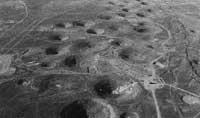Military nuclear tests
1992/12/01 Otaolaurretxi, Jon Iturria: Elhuyar aldizkaria
George Bush and Mikhail Gorbatxov signed an agreement last year to curb nuclear tests, and then the nuclear disarmament of the two major powers has taken its way, even though the former nuclear weapons of the Soviet Union have generated more than one headache. But are nuclear tests necessary?
Who has the nuclear bomb?
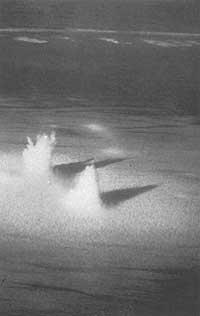
The first nuclear explosion occurred in the New Mexico of the United States, in Alamogordo, on July 16, 1945, and since then almost two thousand have been counted worldwide. Most have been performed in the United States (930 and 217 of them in atmosphere). The list includes the second Soviet Union with 715 explosions (183 in atmosphere) and the third France with 189 explosions (45 in atmosphere). Only the United Kingdom has caused 43 nuclear explosions, but if those carried out in collaboration with the United States are added, the number would increase considerably. China has also caused 36 nuclear explosions and a nearby India in 1974.
Israel and the South African Republic also have nuclear weapons, even if they do not recognize it. Based on the signals detected in the southern Indian Ocean, both powers test together. In addition, Argentina, Brazil and Iraq are taking steps to have a nuclear bomb.
However, the amounts provided to date are indicative. On the one hand they are based on official figures and we know that they have been explosions never declared. On the other hand, detection seismographs do not cover all aspects of the Earth and are uncared areas in the southern hemisphere. As for the detection of tests in the atmosphere, the detection satellite must apply it at the same time so that it can record the signal.
Explosions for what?
The first reason, of course, is political. They say the goal is to show the enemy its own strength (deterrence), but if everyone starts to do so we know the dangerous path that it means, since the next step in the demonstration of the weapon is to use.
Another reason mentioned is the progress of science. Obtaining the nuclear weapon requires mastering many fields: nuclear, atomic and molecular physics, ionized contour statistics, radiation hydrodynamics, quantum electronics, optics, etc. On the other hand, it is necessary to know the physical reality of the thermonuclear reactions that only occur in the stars, since temperatures above ten million degrees and pressures of millions of atmospheres are reached.
Phenomena inherent to nuclear fission (radioactivity, heat, pressure, waste, biological effects, etc. ), have been measured by real explosions. In the mid 80's it took about twenty explosions to prepare a nuclear head, an amount that has dropped to six thanks to advances in computing. However, mere calculation makes it possible to take wrong paths, and occasionally theoretical models are contrasted by real essays.
Nuclear explosions are also used to break new paths. A year ago the United States and the Soviet Union also got the neutron bomb. France has also not refused and some say it has achieved or is about to get a neutron bomb.
Nuclear explosions have formed a succession of tests in the history of the atomic bomb. They have moved from the fission pump to the fusion pump (called H pump) and to the “reinforced irradiation”.
Mururo Problems
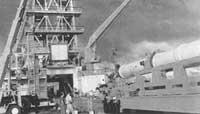
France manufactures its nuclear explosions in the Polynesian Mururo and Fangataufa. He has been subjected to numerous accusations against him, led by Greenpeace. And they are not right. In 1985, the ship “Rainbow Warrior” of this organization was sunk in New Zealand by agents of the French secret services. In that attack that can be considered an example of state terrorism, a Portuguese journalist was killed.
The problems resurfaced in 1987, when Commander Cousteau found remnants of the cesium element 134 in two samples taken in the Murua atoll. This radioactive element has a period of disintegration of two years, and since atmospheric explosions have not occurred after 1974, there is no choice but to have a footprint escape from underground explosions. Therefore, although it is officially said that underground radioactive waste will emerge from here to many centuries, this radioactive isotope has escaped in a very short time.
French general Véricel denies the news by analyzing the same samples that have not found radioactive cessions in his laboratories. He says that remains would also be detected by the Chernobyl accident. However, experts do not accept this explanation, and oceanographer Norman Buske believes that the only reason is that it is a cesium extracted from underground nuclear explosions.
Greenpeace returned to Mururo in 1990 to take samples in nearby waters. First they traveled through international waters and then five people traveled from the Rainbow Warrior to the exit of the atoll to take samples. However, the military were abruptly expelled from there, seizing most of the samples taken.
Norman Buske has written a new report with the results of the latest samples. It indicates that there is a probability of 87% that in the aquatic zooplankton received about 20 kilometers from the trailer is the element Cs 134.
The French military is facing immediately. The Rainbow Warrior boat was not well prepared and the samples taken were not enough to make such tests reliable.
Amazing! First do not let samples be taken and then accuse few samples!
However, the French military requested the International Atomic Energy Agency to examine the waters, and this entity published its report signed by the Messrs. Ballestra and Noshkin. The elements that have been detected in marine waters and plankton are strontium 90, cesium 137 and plutonium 238, 239 and 240. These may be the result of an explosion in the atmosphere that occurred in their day, but they have not found traces of a cesium 134.
Greenpeace is not faithful to the neutrality of the International Atomic Energy Organization and they want the analysis to be carried out in the right way (meeting all requirements). But the military does not leave them with the excuse of national security. The slogan is always answered when you want to hide something shameful.
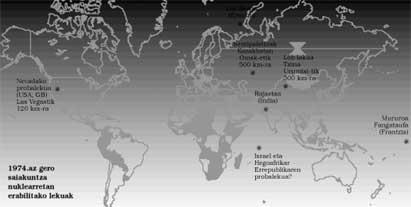
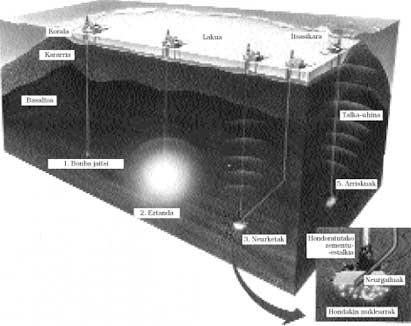
Under the atoll is the basaltic layer of the ancient volcano, where atomic bombs are exploited. After the explosion, 90% of the radioactive elements that are detached from the molten basalts at high temperature in the area and vitrified, are preserved internally.
- Trials are currently conducted in the atoll lake. A hole of 800 to 1,000 meters diameter is made 1.5 meters to the center of the basalt. The atomic bomb drops down, leaving the cable out. Then the gap is closed with remains of basalt and tidal cement.
- When the hole has been tightly closed and solidified the explosion occurs. Measuring devices and cameras have a thousandth second to send your information, as they are quickly destroyed by millions of degrees of heat and millions of atmospheres. In tenth of a second the surrounding basalt evaporates forming a spherical hole. A 10 K explosion leaves a 21 m radius sphere.
- After the burst, the molten lava cools and presses the radioactive elements inside the hole. Twenty years will pass for the temperature to reach 20 at the beginning. The sea water penetrates the basalt ranges to the hole and, next to the side, has to perform another inclined hole.
- As can be seen in detail, part of the glazed lava (6 to 600 g) is taken from the inclined hole to retrieve samples of metal “tracers” integrated into the pump and extract information on neutron reactions.
- The wave of nuclear explosions can break the coral crown resulting in a tidal wave and water rising through the slits contaminating the lake with radioactivity.

Gai honi buruzko eduki gehiago
Elhuyarrek garatutako teknologia





